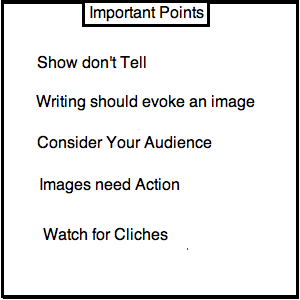|
Evoke An Image Using Concrete LanguageEvoke An Image With The Right Words Mark Twain once said, “The difference between the right word and almost the right word is really a large matter- It’s the difference between the lightning bug and lightning.” He could have said, “word choice is important,” but it wouldn’t have illustrated his point. Lightning bugs and lightning evoke an image in the readers mind and that’s one of the keys to creative writing: Evocation. The Reader's Library Think of your readers mind as a library of images. When a writer evokes these images he or she is tapping into that library, brining up one of those memories and making the reader associates it with the page in front of them. People’s minds are unique and it’s important to consider the audience you’re writing for. There are some images that are almost universal, like the gathering of clouds and the cool, strengthening breeze before a storm; Some images are cultural and lasting- the twin towers collapsing in a cloud smoke; And some images are cultural and quickly fade, such as the celebration after the last Super-bowl. Use the Right Image If you’re writing an article for a national newsletter, evoking the image of your champion sports team parading down the street could be seen more like a conquering hoard than soldiers returning home victorious. However, if you’re writing for the local paper, it may serve you well and make the readers like you. Concrete language uses specific words to tap into the reader’s mental library. Compare these sentences. Too many bullets have flown over our playgrounds. The company is polluting the rivers. The CEO is filling his wallet with dead fish and toasting to the brown water. Can you picture violence in the neighborhood? What about bullets flying over a playground? You may be able to picture a tube sticking out of a building and dumping generic green slime into a river but is it as powerful as the second image: dead fish floating in polluted water and a greedy corporate officer with a full wallet raising a glass of champagne? Keep It Moving Why do the news programs always cut away from the anchors and go live to the scene? Because we love action. Action is the gas that fills the readers engine. Maybe it’s better to think of the reader’s mental library as a collection of video clips, not pictures. The images should have something happening in them. Look at the examples above. There are bullets flying and CEO’s toasting. Both images involve some kind of action. 
Avoid Clichés Like The Dentist's Office Good images can make an article almost as fast as clichés can break it. Don’t fall into that trap. Be original in your writing. When a phrase is used too often readers can no longer picture it because they know too well what it means. For example: Don’t say, “the blind leading the blind,” say, “walking into walls, hand in hand.” Don’t say, “he’s burning the candle at both ends,” say, “he’s filling his glass under a waterfall.” There may be times when you have to say something that lends itself very well to a cliché and you can’t find another image to show it. For example, maybe there is something that a lot of work is going into but isn’t progressing. Don’t say, “they’re spinning their wheels,” or, “chasing their tails.” It’s better to not use an image at all. Evoke an image somewhere else. Not every sentence can or should evoke an image. The writing will lose its effectiveness if the readers have to wade through their mental library too much. It's just as important to tell a story with your writing. Check out this article on telling a story in Non-Fiction. Related Articles: How To Work Through Writing Assignments On Topics You're Not Familiar With... Emotional Writing: Making Your Reader Cry, or Laugh, or Smile, or Frown, or Cringe... More Articles About Creative Non-Fiction Return Home
|